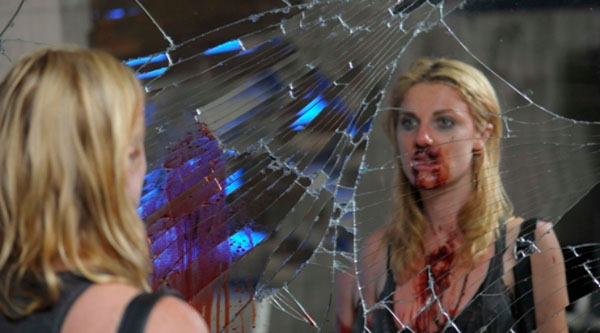SXTAPE
 Wednesday, May 14, 2014 at 11:48AM
Wednesday, May 14, 2014 at 11:48AM Stars: Caitlin Folley, Ian Duncan, Diana Garcia, Daniel Farado, Julie Marcus and Eric Neil Guiterrez.
Writer: Eric Reese.
Director: Bernard Rose.
Rating: 3/5

Although the ‘shakie-cam’ found-footage horror genre prides itself on a style-less aesthetic, the craftsmanship of a director with highly-regarded credentials is plainly evident in Bernard Rose’s LA-set haunted-hospital shocker, sxtape. This latest addition to the Brit’s eclectic career is as far from his period dramas (Immortal Beloved; Anna Karenina; The Kreutzer Sonata) as any film could be, but is steeped in the gritty, grimy minutiae of urban decay and chillingly well-defined supernatural components that made his breakout hit Candyman an enduring cult favourite.
Like the 1992 film that introduced horror fans to Tony Todd’s iconic ‘Man in the Mirror’ boogeyman, Rose finds old-school scares in the heart of the modern metropolis. Back then, it was the Chicago projects; this time around, it is in an abandoned sanitarium in the wilds of inner-city Los Angeles. A vibrant blonde artist named Jill (Caitlin Folley) is being followed about town by her horny new beau, Adam (the barely-glimpsed Ian Duncan), who is recording her as she prepares to launch her first exhibit. Sweet time together fills most of the film’s first act, which bounces from boho-loft bonking to playful public giggles and back again; Rose’s film takes a broadminded approach to energetic and frank lovemaking that will attract tough censor attention in some territories.
Adam surprises Jill by taking her to a dingy old mansion to get her thoughts on the place as a gallery space. He surprises her further when, as some kind of bad joke, he straps her to a guerney and briefly leaves her briefly; this allows for the film’s first big scare and the beginning of Jill and Adam’s descent into the vengeful spiritual memory of the building. The plotting comparisons to The Shining grow increasingly apparent (Rose references the ‘naked hottie/old hag’ mirror moment from Kubrick’s film at one point), though it is hardly the first to do so and ultimately carves out its own satisfying narrative path.
Just as fellow veteran Barry Levinson showed on his criminally-underseen handheld horror work The Bay, the format can reinvigorate a director who has spent a career grinding through the traditionally cumbersome production process. Rose held his own camera and cut his own footage on sxtape and the confidence of an old-pro given free reign comes through in every well-timed scare. He has major assets in leading lady Folley, whose all-or-nothing performance goes from darling free-spirit to bloody, shrieking banshee, and production designer Bradd Fillmann, whose vision of a hellish hospital landscape is clearly influenced by those first-person horror games that I refuse to play because they terrify me.
sxtape never fully overcomes the inherent problems that dog the found-footage film - why don’t they just leave? why would they keep filming? why doesn’t the camera battery run out? who adds the post-production elements? The film has its own unanswered conundrums, such as who would still be running power to the clearly derelict building, although the biggest logical misstep in Eric Reese’s script comes in the form of a prologue in which a cop questions a bloody and distressed Jill; if she is seen to have survived and the fate of her companions is in no doubt, who finds and watches the footage?
Fortunately, Rose and his team generate enough goodwill with some solid scares and a truly icky final frame to overcome any shortcomings. sxtape breathes some fresh air into the handheld-horror genre via the skill of a deft, proven journeyman filmmaker who is clearly enjoying himself.
 Haunted house,
Haunted house,  candyman,
candyman,  found footage,
found footage,  horror,
horror,  sxtape
sxtape 